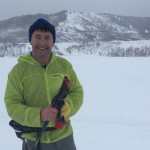
Travel and Adventure Writing is some of the most enjoyable writing I do. It gives me an excuse to get out into the wild and leave behind all the email, texts, phone messages and other things I need to keep track of as a writer and founder of The Writer’s Workshop.
I had the pleasure of going on a press trip recently to the Home Ranch in Colorado. During the three-day visit, I took skate skiing lessons from Matson Tew, one of the guides at the ranch. The ranch offers lessons for cross country, skate skiing and even telemark skiing, which allows guests to try all kinds of skiing. I have telemarked for years and done classic cross country skiing a lot, but I had done little skate skiing and the times I’d done it, it had kicked my ass. It was so strenuous that I could only do it for a few hundred yards. But I figured if I had good instruction and the right equipment and a good course, I could at least make some progress, and get some material for travel and adventure writing.
In addition to taking lessons, I planned to write about it. The lessons and trip were essentially research for me. I no longer attend many city council or county commissioners meetings, as I did when I was a newspaper reporter, but I try to get out in the field as much as possible. I always learn a lot on such trips, soaking in the geography, the landscape, the people. And I usually return with a story as I did on this trip. As I teach students in my Travel writing classes, Seattle writing classes, and online classes, I like to use scene to organize such stories. Take a look at the story I wrote about the trip for a demonstration of how to do this. http://www.mountaingazette.com/blogs/kicking-and-gliding-at-the-home-ranch/
 The Writer's Workshop
The Writer's Workshop 













